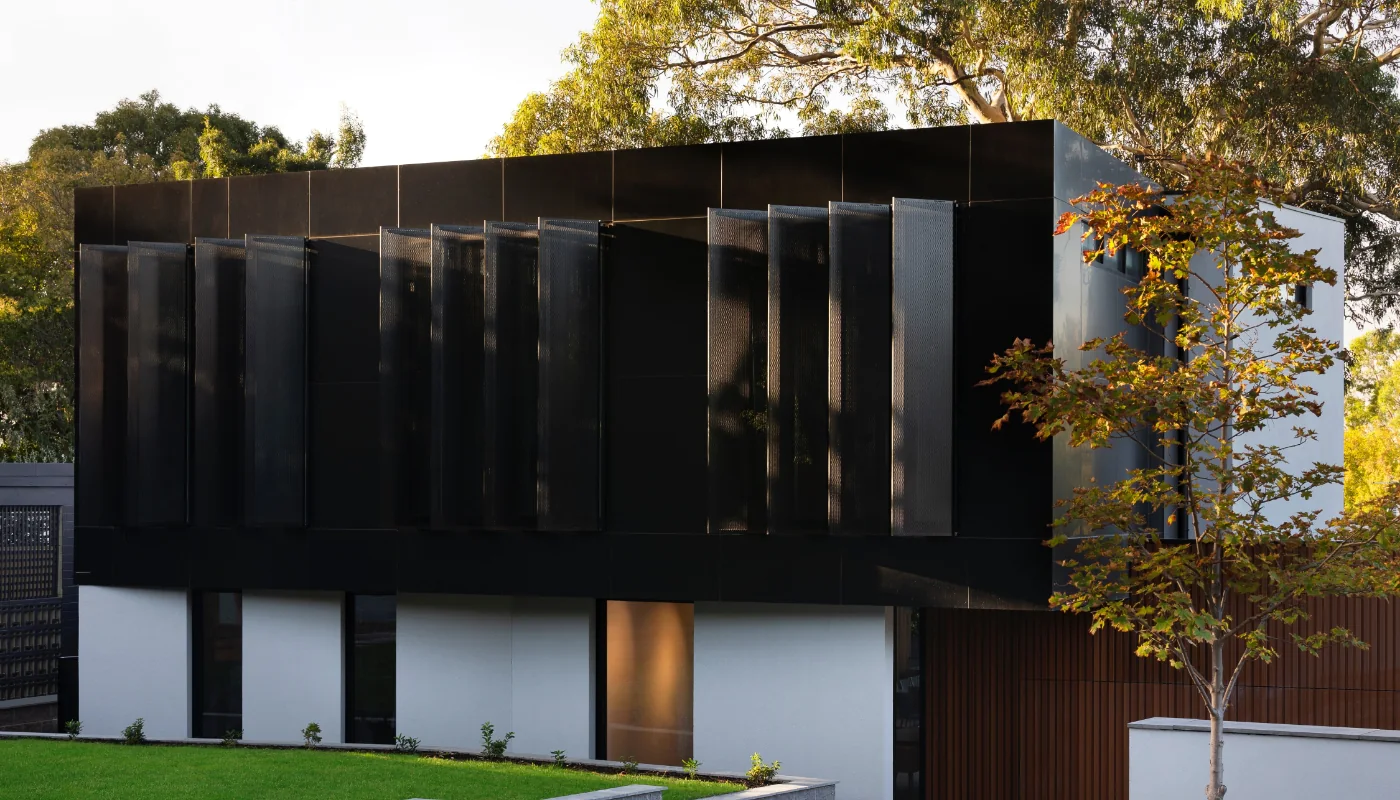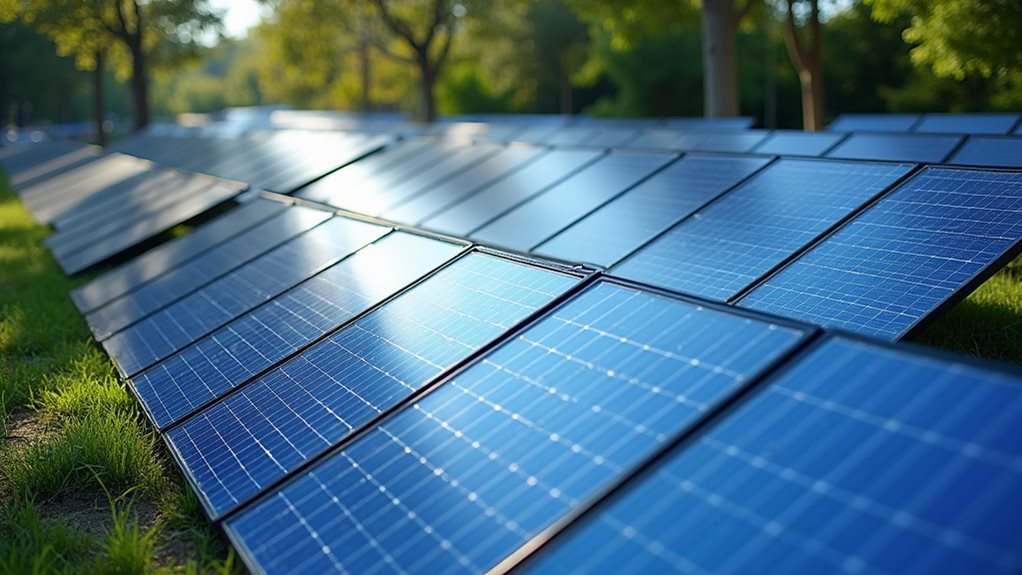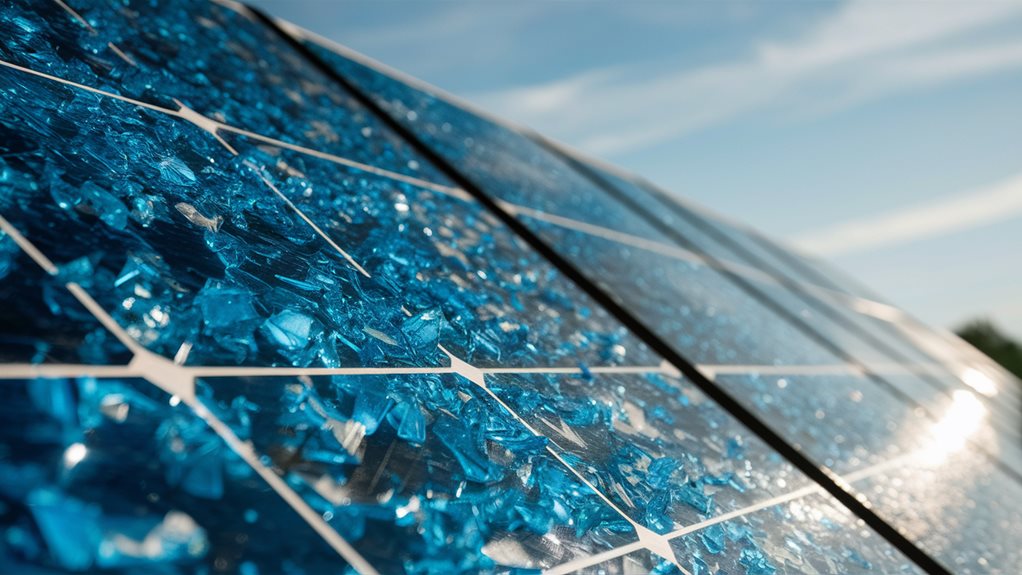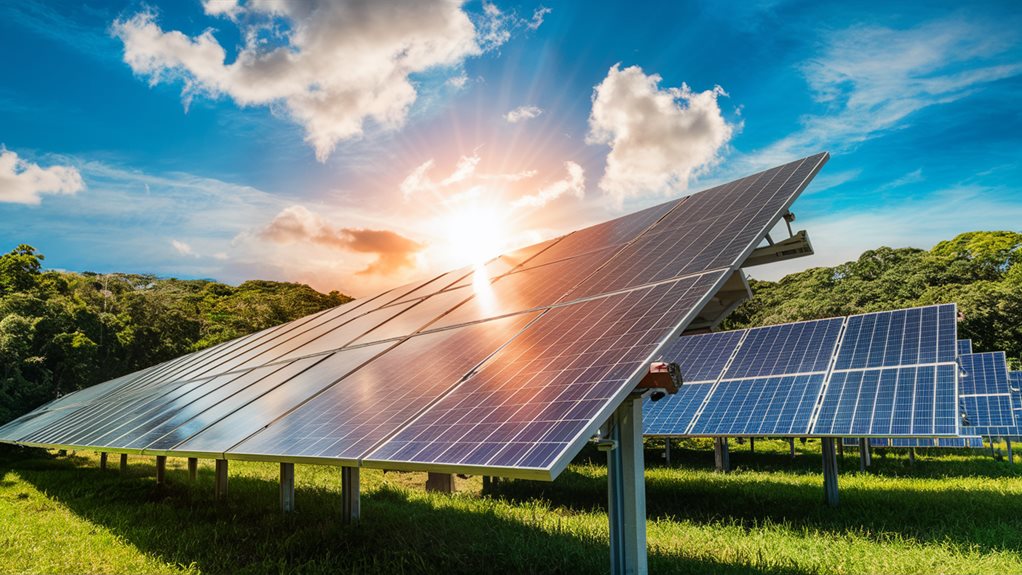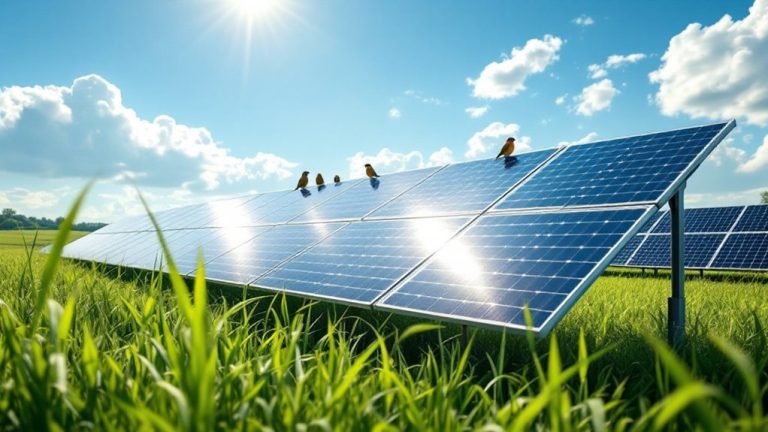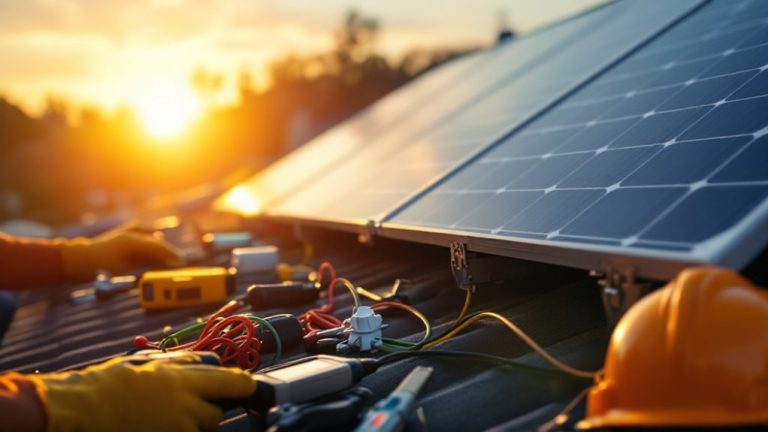Polycrystalline solar panels represent a significant segment in the solar industry due to their unique structural and economic attributes. Composed of numerous silicon fragments, these panels harbor a distinctive aesthetic and maintain durability across varied climatic conditions. With cost-effective manufacturing and eco-friendly production processes, they present a practical alternative in the energy sector. However, how do they measure up against their monocrystalline counterparts, and what specific aspects make them a preferable choice for certain applications? Exploring the intricacies of their design and application will shed light on their enduring presence in sustainable energy solutions.
Expert Highlights
- Polycrystalline solar panels lower costs with simpler manufacturing and multi-crystal silicon compositions.
- Efficiency ranges from 13% to 17%, suitable for budget-conscious consumers with ample installation space.
- Eco-friendly production reduces waste and carbon footprint while maximizing silicon usage.
- Panels are durable against harsh weather, maintaining 80% efficiency over decades.
- Ideal for large residential areas, commercial solar farms, and portable applications in high-temperature regions.
Definition of Polycrystalline Panels
Polycrystalline solar panels are composed of multiple silicon crystals, shaped during a manufacturing process that involves melting silicon fragments together to form the wafers. This crystal structure, while providing economic and material efficiency, typically results in lower energy conversion efficiency compared to their monocrystalline counterparts, with efficiency rates generally in the 13-16% range. These panels are particularly notable for their more eco-friendly manufacturing process, as they produce less silicon waste compared to monocrystalline solar panels. The mosaic-like appearance of these panels reflects their distinct multi-crystal composition, which influences both their functionality and cost-effectiveness in solar energy applications.
Manufacturing Process Overview
Being renowned for their distinctive mosaic-like appearance, polycrystalline solar panels are fabricated by melting together multiple silicon crystals to form wafers. The manufacturing process involves cooling the silicon ingot, slicing it into wafers, and applying an anti-reflective coating. Metal conductors are printed, followed by wiring the wafers and assembling them into a panel. In the process of creating polycrystalline panels, gallium or boron is added to give the silicon a positive charge. This efficient process yields eco-friendly panels with reduced production waste.
Crystal Structure Characteristics
Characterized by a distinctive grainy texture, polycrystalline solar panels are defined by their crystal structure, which consists of multiple silicon crystals melded together. This mosaic-like appearance results from disorganized and variously oriented silicon crystals, forming noticeable grain boundaries. These boundaries influence electron flow within the cells, impacting the panel's electricity generation capabilities. The eco-friendly nature arises from maximum silicon usage in production, minimizing material waste. While polycrystalline panels are less efficient than their monocrystalline counterparts, they remain popular due to their lower cost and sufficient efficiency for various applications.
Energy Efficiency Comparison
Moving from the intricate details of crystal structure characteristics, the focus now shifts to the energy efficiency comparison of solar panels. Polycrystalline solar panels, defined by their composition of multiple silicon crystals, have an efficiency range of 13% to 17%. They often yield lower power outputs but excel in cost-effectiveness, especially in large installations with ample space. While polycrystalline panels have a blue hue because they are made by melting multiple silicon crystals, their efficiency tends to be lower compared to monocrystalline panels.
- Efficiency: 13% to 17%
- Power Output: 240-300 watts
- Electron Movement: Challenging
- Space Requirement: More needed
- Cost: More affordable per watt
Benefits
Polycrystalline solar panels present a cost-effective energy solution, offering significant savings on initial investment compared to other panel types. They are manufactured using melted silicon crystals, which contribute to their lower production costs. Their durable construction guarantees a long lifespan, making them a reliable choice for both residential and commercial applications. Additionally, their versatility in installation, combined with an eco-friendly manufacturing process, makes these panels an attractive option for environmentally conscious consumers.
Cost-Effective Energy Solution
A cost-effective energy solution for those seeking sustainable power options is polycrystalline solar panels. These panels boast lower production costs due to their simpler manufacturing process and provide affordability, making them appealing to budget-conscious consumers. Despite their lower efficiency compared to monocrystalline panels, polycrystalline panels can be a viable choice for homeowners with ample roof space, as they are less expensive and can still provide substantial energy savings over time.
In addition, they offer notable savings potential and environmental benefits, thanks to their reduced carbon footprint.
- Lower manufacturing costs
- Affordable alternative to monocrystalline panels
- Reduced carbon emissions
- Significant electricity bill savings
- Widespread accessibility
Durable Panel Construction
Durability is a key advantage of polycrystalline solar panels, offering long-term resilience under various environmental conditions. With anodized aluminum frames and tempered glass, these panels withstand wind, hail, and snow. Their silicon structure reduces degradation rates, ensuring over 80% efficiency after 25 years. They resist extreme temperatures and perform well under diverse climates, maintaining stability, strength, and reliable output over decades. Moreover, polycrystalline panels are cost-effective, making them an economical choice for both residential and large-scale solar installations.
Versatile Installation Options
Leveraging the robust construction established in polycrystalline solar panels, these energy solutions offer versatile installation options that extend their applicability to a wide range of settings. Ideal for everything from sprawling residential rooftops and industrial complexes to portable applications, they excel in diverse environments without compromising efficiency. These panels not only provide cost-effective solutions but also aid in reducing reliance on fossil fuels. Their ability to adapt to various needs enhances their appeal to both homeowners and businesses.
Suitable for large residential spaces
Ideal for commercial solar farms
Perfect for portable solar applications
Efficient in high-temperature areas
Cost-effective for expansive installations
Eco-Friendly Manufacturing Process
Emphasizing eco-conscious innovation, the manufacturing process of polycrystalline solar panels showcases several formidable environmental benefits. Utilizing lower-purity silicon, these panels reduce energy use and carbon footprint, with potential integration of recycled materials for enhanced sustainability. As polycrystalline panels are suitable for residential and commercial applications, they appeal to a wider audience seeking budget-friendly renewable energy options. Production involves efficient resource utilization, minimized waste, and less energy consumption than monocrystalline alternatives, fostering an eco-friendly approach while contributing to long-term clean energy solutions and a sustainable supply chain.
Manufacturing Involves Silicon Fragments
The manufacturing process of polycrystalline solar panels begins with the fusion of silicon fragments, an approach that optimizes cost-effectiveness while utilizing readily available materials. However, addressing the environmental implications of this process is vital, as the techniques employed can lead to waste byproducts. Though polycrystalline panels are less efficient than their monocrystalline counterparts, achieving only 13% to 16% efficiency, they remain a popular choice due to their lower production costs. Below is a table summarizing key aspects related to silicon fragment fusion, manufacturing cost-efficiency, and the environmental impact.
| Aspect |
Description |
Considerations |
| Silicon Fragment Fusion |
Combines fragments into polycrystalline ingots |
Material utilization |
| Cost-Effectiveness |
Lower cost compared to monocrystalline production |
Economic advantages |
| Environmental Impact |
Possible waste generation |
Waste management |
| Purification Methods |
Zone, distill, electrolytic, Siemens refining |
Process purity levels |
| Efficiency | 13% to 16% conversion efficiency | Reflects on cost savings
Silicon Fragment Fusion Process
In the domain of polycrystalline solar panel manufacturing, harnessing the power of silicon fragments is a pivotal process. This involves melting numerous silicon fragments at elevated temperatures within an arc furnace, resulting in the creation of uniform silicon wafers.
The process entails several key steps:
- Melting silicon fragments at high temperatures
- Formation of large silicon sheets
- Use of a cylindrical furnace
- Production of high-purity silicon
- Contributing to efficient solar panel creation
Cost-Effective Manufacturing Technique
Innovation in solar technology often hinges on balancing cost with efficiency, and the cost-effective manufacturing technique employed in the creation of polycrystalline solar panels exemplifies this balance.
Environmental Impact and Waste
Balancing cost with efficiency in the production of polycrystalline solar panels naturally extends to evaluating their environmental impact and waste production. The manufacturing process is less wasteful than monocrystalline methods, as it utilizes silicon fragments. This approach not only conserves resources but also enhances sustainability.
- Reduced waste compared to monocrystalline panels
- Reuse of silicon fragments from excess materials
- Lower energy consumption in production
- High recyclability rate
- Minimal environmental footprint
FAQ
How Do Polycrystalline Panels Perform in Low-Light Conditions?
Polycrystalline panels excel in low-light conditions due to their ability to absorb light from different angles, capturing more diffuse light and generating electricity from a wider range of wavelengths, offering a competitive alternative in areas with frequent cloud cover.
Are Polycrystalline Panels Suitable for Residential or Commercial Applications?
Polycrystalline panels are suitable for both residential and commercial applications due to their cost-effectiveness, durability, and adaptability to various installation sizes. Their performance in different climate conditions and affordability make them an ideal choice for diverse energy solutions.
What Maintenance Is Required for Polycrystalline Solar Panels?
The maintenance of polycrystalline solar panels involves regular cleaning, debris removal, electrical inspections, performance monitoring, and protective measures against environmental factors. Additionally, professional servicing and system evaluations are recommended to guarantee efficient and lasting performance.
How Do Polycrystalline Panels Compare in Cost to Monocrystalline Panels?
When comparing costs, polycrystalline panels are approximately 20% cheaper than monocrystalline panels. However, their lower efficiency may require more units to achieve similar power output, potentially offsetting initial savings with additional installation and long-term costs.
What Is the Lifespan of Polycrystalline Solar Panels?
Polycrystalline solar panels generally have a lifespan of 25-30 years, contingent on material quality and environmental conditions. Proper maintenance can prolong their functionality, though they might degrade at a rate of 0.3% to 1% annually.
Experts Final Thoughts
Polycrystalline solar panels, with their mosaic-like appearance, result from a cost-effective manufacturing process involving multiple silicon crystals. Despite having slightly lower energy conversion efficiency compared to monocrystalline counterparts, these panels offer durability and resilience, making them suitable for various applications. The fusion of silicon fragments via a simplified production technique contributes to their economic viability. Additionally, the eco-friendly manufacturing process, characterized by minimal waste and a reduced carbon footprint, solidifies their role as sustainable energy solutions.

